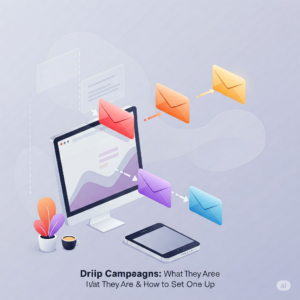Drip Campaigns: What They Are & How to Set One Up
 If you’ve ever wondered how some brands keep you hooked with perfectly timed emails — showing up just when you need them without overwhelming your inbox — then you’ve already met drip campaigns in action. But what exactly is a drip campaign, why does it matter, and how can you set one up to work like magic for your business?
If you’ve ever wondered how some brands keep you hooked with perfectly timed emails — showing up just when you need them without overwhelming your inbox — then you’ve already met drip campaigns in action. But what exactly is a drip campaign, why does it matter, and how can you set one up to work like magic for your business?
Let’s break it down.
What Is a Drip Campaign, Really?
Think of a drip campaign as a slow and steady stream of carefully crafted messages sent automatically to your audience over time. The goal? To nurture your leads, educate your customers, or guide prospects toward making a purchase — all without you having to hit “send” every time.
The word “drip” is perfect here: it’s about sending small, consistent drops of content that gradually build trust and interest, rather than flooding people’s inboxes all at once.
Why Should You Care About Drip Campaigns?
Here’s the truth: most people aren’t ready to buy from you on their first visit. They need time, context, and value before they commit. Drip campaigns are your secret weapon to stay top-of-mind, deliver value, and gently nudge your audience down the funnel.
Brands like HubSpot, Mailchimp, and Neil Patel swear by drip campaigns because:
They increase engagement and open rates
They build meaningful customer relationships
They boost conversion rates without being pushy
They save you time by automating follow-ups
The Anatomy of a Successful Drip Campaign
Before you dive into tools and templates, nail down these essentials:
1. Define Your Goal
Are you onboarding new users, educating prospects, re-engaging inactive customers, or promoting a new product? Your goal shapes the entire campaign.
2. Map Your Customer Journey
Understand the stages your audience goes through—from awareness to decision—and tailor your messages accordingly.
3. Segment Your Audience
Not everyone needs the same message. Segment based on behavior, demographics, or interests to make your campaign relevant.
4. Plan Your Content Calendar
Decide how many emails you’ll send, the timing between each, and what each email will cover.
How to Set Up a Drip Campaign: Step-by-Step
Ready to roll? Here’s your blueprint:
Step 1: Choose the Right Tool
Popular options include Mailchimp, ActiveCampaign, ConvertKit, or HubSpot. These platforms make automation simple, even if you’re a newbie.
Step 2: Create Your Email Sequence
Write emails that flow naturally—start with a warm welcome, follow up with valuable content, then offer your solution. Keep each email concise, friendly, and action-oriented.
Step 3: Set Triggers and Timing
Triggers might be signing up for a newsletter, downloading an ebook, or abandoning a cart. Space your emails logically — maybe every 2-3 days or weekly, depending on your audience.
Step 4: Test and Tweak
Before going live, test your emails for readability and deliverability. After launching, watch your open and click rates, and adjust your content or timing to improve results.
Pro Tips to Make Your Drip Campaign Shine
Personalize wherever possible. Use your subscriber’s name and tailor content based on their actions.
Don’t overdo it. Too many emails can backfire and lead to unsubscribes.
Add value consistently. Each message should educate, entertain, or solve a problem.
Use strong calls to action. Tell your readers exactly what you want them to do next.
Final Thought
Drip campaigns are like planting seeds for your relationship with customers — you nurture them patiently and watch them grow into loyal advocates. If you haven’t already started using them, today’s a perfect day to dive in.
Need a hand getting started? Reach out, and let’s craft a drip campaign that truly speaks to your audience.
